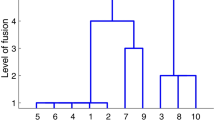Abstract
Eight different variable selection techniques for model-based and non-model-based clustering are evaluated across a wide range of cluster structures. It is shown that several methods have difficulties when non-informative variables (i.e., random noise) are included in the model. Furthermore, the distribution of the random noise greatly impacts the performance of nearly all of the variable selection procedures. Overall, a variable selection technique based on a variance-to-range weighting procedure coupled with the largest decreases in within-cluster sums of squares error performed the best. On the other hand, variable selection methods used in conjunction with finite mixture models performed the worst.
Similar content being viewed by others
References
Banfield, J.D., & Raftery, A.E. (1993). Model-based Gaussian and non-Gaussian clustering. Biometrics, 49, 803–821.
Bartholomew, D.J., & Knott, M. (1999). Latent variable models and factor analysis. London: Arnold.
Brusco, M.J., & Cradit, J.D. (2001). A variable-selection heuristic for K-means clustering. Psychometrika, 66, 249–270.
Carmone, F.J., Kara, A., & Maxwell, S. (1999). HINoV: A new model to improve market segment definition by identifying noisy variables. Journal of Marketing Research, 36, 501–509.
Cormack, R.M. (1971). A review of classification. Journal of the Royal Statistical Society, Series A, 134, 321–367.
Dempster, A.P., Laird, N.M., & Rubin, D.B. (1977). Maximum likelihood from incomplete data via the E-M algorithm. Journal of the Royal Statistical Society, Series B, 39, 1–38.
DeSarbo, W.S., Carroll, J.D., Clark, L.A., & Green, P.E. (1984). Synthesized clustering: A method for amalgamating alternative clustering bases with differential weighting of variables. Psychometrika, 49, 57–78.
De Soete, G., DeSarbo, W.S., & Carroll, J.D. (1985). Optimal variable weighting for hierarchical clustering: An alternative least-squares algorithm. Journal of Classification, 2, 173–192.
Donoghue, J.R. (1990). Univariate screening measures for cluster analysis. Multivariate Behavioral Research, 30, 385–427.
Dy, J.G., & Brodley, C.E. (2004). Feature selection for unsupervised learning. Journal of Machine Learning Research, 5, 845–889.
Fowlkes, E.B., & Mallows, C.L. (1983). A method for comparing two hierarchical clusterings. Journal of the American Statistical Association, 78, 553–569.
Fowlkes, E.B., Gnanadesikan, R., & Kettenring, J.R. (1988). Variable selection in clustering. Journal of Classification, 5, 205–228.
Friedman, J.H. (1987). Exploratory projection pursuit. Journal of the American Statistical Association, 82, 249–266.
Friedman, J.H., & Meulman, J.J. (2004). Clustering objects on subsets of variables. Journal of the Royal Statistical Society, Series B, 66, 1–25.
Friedman, J.H., & Tukey, J.W. (1974). A projection pursuit algorithm for exploratory data analysis. IEEE Transactions on Computing, 23, 881–890.
Gnanadesikan, R., Kettenring, J.R., & Tsao, S.L. (1995). Weighting and selection of variables for cluster analysis. Journal of Classification, 12, 113–136.
Goffe, W.L., Ferrier, G.D., & Rogers, J. (1994). Global optimization of statistical functions with simulated annealing. Journal of Econometrics, 60, 65–99.
Green, P.E., Carmone, F.J., & Kim, J. (1990). A preliminary study of optimal variable weighting in k-means clustering. Journal of Classification, 7, 271–285.
Hubert, L.J., & Arabie, P. (1985). Comparing partitions. Journal of Classification, 2, 193–218.
Kruskal, J.B. (1969). Toward a practical method which helps uncover the structure of a set of observations by finding the line transformation which optimizes a new index of condensation. In R.C. Milton, & J.A. Nelder (Eds.), Statistical Computation (pp. 427–440). New York: Academic Press.
Law, M.H.C., Figueiredo, M.A.T., & Jain, A.K. (2004). Simultaneous feature selection and clustering using mixture models. IEEE Transactions on Pattern Analysis and Machine Intelligence, 26, 1154–1166.
Martinez, W.L., & Martinez, A.R. (2001). Computational statistics handbook with MATLAB. Boca Raton: Chapman & Hall.
Martinez, W.L., & Martinez, A.R. (2005). Exploratory data analysis with MATLAB. Boca Raton: Chapman & Hall.
McLachlan, G.J., & Basford, K.E. (1988). Mixture models: Inference and applications to clustering. New York: Dekker.
McLachlan, G.J., & Krishnan, T. (1997). The EM algorithm and extensions. New York: Wiley.
McLachlan, G.J., & Peel, D. (2000). Finite mixture models. New York: Wiley.
Milligan, G.W. (1980). An examination of the effect of six types of error perturbation on fifteen clustering algorithms. Psychometrika, 45, 325–342.
Milligan, G.W. (1985). An algorithm for generating artificial test clusters. Psychometrika, 50, 23–127.
Milligan, G.W. (1989). A validation study of a variable weighting algorithm for cluster analysis. Journal of Classification, 6, 53–71.
Montanari, A., & Lizzani, L. (2001). A projection pursuit approach to variable selection. Computational Statistics & Data Analysis, 35, 463–473.
Raftery, A.E., & Dean, N. (2006). Variable selection for model-based clustering. Journal of the American Statistical Association, 101, 168–178.
Steinley, D. (2003). Local optima in K-means clustering: What you don’t know may hurt you. Psychological Methods, 8, 294–304.
Steinley, D. (2004a). Standardizing variables in K-means clustering. In D. Banks, L. House, F.R. McMorris, P. Arabie, & W. Gaul (Eds.), Classification, clustering, and data mining applications (pp. 53–60). New York: Springer.
Steinley, D. (2004b). Properties of the Hubert–Arabie adjusted Rand index. Psychological Methods, 9, 386–396.
Steinley, D. (2006a). K-means clustering: A half-century synthesis. British Journal of Mathematical and Statistical Psychology, 59, 1–34.
Steinley, D. (2006b). Profiling local optima in K-means clustering: Developing a diagnostic technique. Psychological Methods, 11, 178–192.
Steinley, D., & Brusco, M.J. (2007, in press). A new variable weighting and selection procedure for K-means cluster analysis. Psychometrika.
Steinley, D., & Henson, R. (2005). OCLUS: An analytic method for generating clusters with known overlap. Journal of Classification, 22, 221–250.
Steinley, D., & McDonald, R.P. (2007). Examining factor score distributions to determine the nature of latent spaces. Multivariate Behavioral Research, 42, 133–156.
Tibshirani, R., Walther, G., & Hastie, T. (2001). Estimating the number of clusters in a data set via the gap statistic. Journal of the Royal Statistical Society, Series B, 63, 411–423.
van Buuren, S.V., & Heiser, W.J. (1989). Clustering N objects into K groups under an optimal scaling of variables. Psychometrika, 54, 699–706.
Author information
Authors and Affiliations
Corresponding author
Rights and permissions
About this article
Cite this article
Steinley, D., Brusco, M.J. Selection of Variables in Cluster Analysis: An Empirical Comparison of Eight Procedures. Psychometrika 73, 125–144 (2008). https://doi.org/10.1007/s11336-007-9019-y
Received:
Revised:
Published:
Issue Date:
DOI: https://doi.org/10.1007/s11336-007-9019-y




